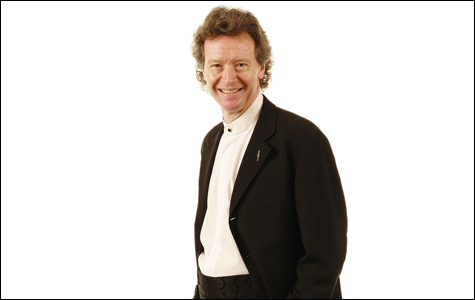Handel and Haydn's 'Fireworks' at Symphony Hall, January 25, 2008
By JEFFREY GANTZ | January 29, 2008

Harry Christophers
|
The Handel and Haydn Society’s “Royal Fireworks” program last weekend was meant to mark the season’s first appearance of H&H artistic adviser Roger Norrington on the podium, but then Norrington’s main gig, the Stuttgart Radio Symphony Orchestra, landed a major Japanese tour, and, well, that’s what happens in this age of multi-tasking celebrity conductors. Stepping in for Sir Roger (who’s still scheduled to lead the Haydn program that will conclude the H&H season April 4 and 6) was Harry Christophers, who had made his H&H debut in December with the society’s annual Messiah. The program changed slightly: Handel’s Royal Fireworks Music and music from Purcell’s The Fairy Queen, as announced; Bach’s Overture No. 3 instead of No. 4; the G-major suite from Handel’s Water Music instead of a suite from Rameau’s Les Boréades.
It made for an unusually short evening — Friday the music ended at 9:35 — but that was the only cause for complaint. Christophers, the founder and leader of the distinguished English a cappella group the Sixteen (try their recording of John Taverner’s Missa Gloria Tibi Trinitas), created an intimate atmosphere — not easy in Symphony Hall — by having most of his 30 or so musicians stand (only the three cellists and the harpsichordist and theorbo player sat) and by conducting not only without a baton but from the floor, with no podium. The result was bracing rather than boring Baroque, with lilt and flow and point. Christophers prowled the floor like a big cat, coiling and uncoiling, scrunching his shoulders, shimmying, strutting, making big phrases with his hands that drew big phrases from the orchestra. The Water Music suite, with Christopher Krueger on Baroque flute, was shaped by contrasts in texture and volume. The opening of the Bach Overture was ceremonial and yet kept moving forward in its dance pulse; the Air (the so-called “Air on the G-String”) reveled in the firm, lucid bottom of the cellos and the bass. The period brass had their share of bobbles, and the deep bray of Douglas Yeo’s serpent got lost in Paul Pitts’s side drum at the beginning of the Royal Fireworks Music, but there was a Baroque bonanza — modern instruments never sound like this — in the serene interchange between trumpets and horns that followed. Even the concluding Réjouissance movement stomped, a four-on-the-floor Irish reel.
 Related
Related:
Old and new, No stuffed shirts, please, Good vibrations?, More 
- Old and new
There was hardly a concert I was more eager to hear than the Celebrity Series of Boston’s celebration of pianist Leon Fleisher’s 80th birthday.
- No stuffed shirts, please
“Winter, winter, spring, and winter.”
- Good vibrations?
The string vibrato developed as an orchestral sonority only in the 20th century. Does that mean that your favorite performances of everyone from Bach to Berg don’t really sound the way the composer intended?
- Lift every voice!
Opera is the big word for 2009.
- Anniversaries and other occasions
Anniversaries, however fabricated, can still be useful. This year commemorates the 200th birthday of Felix Mendelssohn, the 150th birthday of Victor Herbert (both recently celebrated with intensive "orgies" on WHRB), the 200th anniversary of Haydn's death, and the 250th anniversary of Handel's death.
- In the swim
My head’s swimming.
- Bach beat
Composers John Harbison and Peter Lieberson are big presences this spring.
- Over (and under) the top
With only one rehearsal, 31-year-old BSO Assistant Conductor Julian Kuerti confronted a challenging two-and-a-half-hour program of not-quite-standard 19th- and 20th-century repertoire.
- In Search of Mozart
Phil Grabsky had Amadeus squarely in his sights when he set out to make this documentary celebrating the 250th anniversary of the composer’s birth.
- Unembarrassed riches
Some weeks Boston has such musical riches, one wouldn’t want to be anywhere else.
- From Knoxville to Swan Lake and back
As our most prestigious classical-music institution, the Boston Symphony Orchestra ought to be every year’s headliner, and once again, under the adventuresome direction of James Levine, it is.
- Less

 Topics
Topics:
Live Reviews
, Handel and Haydn Society, Roger Norrington, Christopher Krueger, More  , Handel and Haydn Society, Roger Norrington, Christopher Krueger, Harry Christophers, Stuttgart Radio Symphony Orchestra, Less
, Handel and Haydn Society, Roger Norrington, Christopher Krueger, Harry Christophers, Stuttgart Radio Symphony Orchestra, Less 